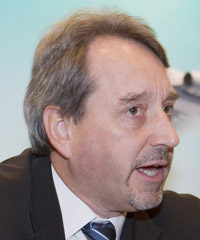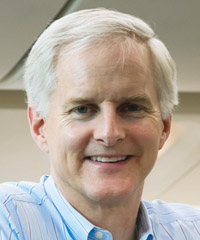56th AAPA Assembly of Presidents
ASIA CHANGING AVIATION LANDSCAPE
‘AAPA determined to challenge government constraints with renewed vigour’
December 1st 2012
Asia-Pacific airline chiefs called on their governments to take a greater role in global aviation policy-making at the 56th Association of Asia Pacific Airlines (AAPA) Assembly of Presidents in Kuala Lumpur last month. Read More »
 |
| 'Asia-Pacific carriers … are still hampered by the straitjacket of over-reaching government policies, particularly from the United States and European Union' |
| Andrew Herdman Director General AAPA |
They also argued for an end to higher taxes on their operations. The leaders cited the region’s growing share of global air traffic. They said that Asia’s airlines were leading the way in changing the landscape of aviation with new business models, creative products and unprecedented partnerships.
AAPA director general, Andrew Herdman, said innovative ideas were helping Asian full service carriers survive the economic slump. They had seen them remain at the forefront of new global partnerships and multi-brand strategies.
As examples, Herdman quoted the launch of three low-cost carriers (LCCs) in Japan, a new Singapore Airlines (SIA) long-haul LCC, Scoot, and a new hybrid airline, Thai Smile, as well as the recent partnership agreements between Emirates and Qantas and Virgin Australia and Tiger Airways.
“Two thousand and twelve is proving to be a pivotal year for the global air transport industry, with enterprising carriers from the Asia-Pacific at the forefront of major developments,” said Herdman.
“Ground-breaking deals that would have been unimaginable a year ago are rapidly turning previous rivals into long-term strategic partners. The new competitive landscape is providing consumers with a wide variety of new travel options and adding tremendous momentum to the rise of Asian carriers in the global industry.”
But despite the bold initiatives being taken by carriers to change the old order, governments were still oblivious to the counter-productive impact of never-ending new legislation and taxation, he said.
“Asia-Pacific carriers are innovation leaders who are playing a major role in global industry developments, but they are still hampered by the straitjacket of over-reaching government policies, particularly from the United States and the European Union, impacting global aviation,” said Herdman.
“With the shift of economic influence and commercial dynamism towards Asia continuing at an accelerating pace, the AAPA is determined to challenge these government constraints with renewed vigour,” he said.
| 'I believe for each airline in each [Asian] country we have to see how we can help our governments to understand the issues' |
| Goh Choon Phong Chief Executive Singapore Airlines |
Shifting the balance of aviation regulatory power from west to east won’t be easy. John Byerly, a former U.S. under-secretary of state for transportation and for years Washington’s chief air rights negotiator, said the “mantle of innovation” is no longer in the North Atlantic, in Europe or the U.S., but had shifted to Asia, Latin America and the Middle East.
“That’s where new business models, cross border mergers and new ways of approaching customers are arising. It is exciting stuff,” he said.
Speaking during an executive panel at the Assembly, Byerly said to be an effective voice in international aviation unity was needed.
“The U.S. and Europe can talk with one voice. I think the Asian governments need to look at ways to do that more effectively. I don’t want to replace European and North American hegemony in aviation rule-making with Asian hegemony,” he said.
“What we need is global consensus. Whether it’s the environment or regulation we need a global set of solutions more today than ever before.”
But Byerly said it had to be done through the International Civil Aviation Organization (ICAO). “IATA [International Air Transport Association] is doing a fantastic job in pushing standardization, but ICAO is the answer.
“ICAO is not an ‘it’, it’s a ‘we’. It’s not bureaucrats. It’s 191 countries. They have to be the ones who come together. ICAO can have a role in bringing more openness, making the rules and regulations and getting more international consensus.
“Asia can play an incredibly important role because it has become so important to aviation,” he said.
 |
| 'The challenge is for the AAPA to extend its own remit and do an even better job of representing what Asian aviation has to say' |
| John Slosar Chief Executive Cathay Pacific Airways |
SIA chief executive, Goh Choon Phong, agreed that unlike the U.S. and Europe, which had a cohesive approach to aviation policy, Asia was a lot more diverse.
“We have many different issues that each country must resolve. Therefore, there is less cohesion in getting everyone together, uniting their views and being able to push a common agenda,” he said.
“But I believe for each airline in each country we have to see how we can help our governments to understand the issues and bring all this together so that we can truly become a united body to ensure that Asia has its rightful vote in the international agenda.”
Another major topic of discussion was the growing tax burden on airlines. As Goh said: “It is more important to look for ways to bring more cost efficiencies to the industry rather than finding new ways of taxing it”.
To reflect government attitudes towards airlines Herdman quoted former U.S. president. Ronald Reagan: “If it moves, tax it. If it keeps moving, regulate it. If it stops moving, subsidize it.”
Cathay Pacific chief executive, John Slosar, also quoted Reagan with the words: “The nearest thing to immortality on the face of the earth is government tax, because once it is in place it tends to stay forever.”
He said taxes were a huge danger to the industry in every aspect of the business. “Aviation must be the most taxed, regulated, dissected industry we have ever seen. It seems totally out of place within the context of how much aviation contributes to the world and regional economies and everything else,” said Slosar.
“If it’s not ETS, it’s passenger bills of rights, it’s ATC systems. It is new taxes right, left and centre. The challenge is for the AAPA to extend its own remit and do an even better job of representing what Asian aviation has to say about how the industry is developing.”
IATA director general, Tony Tyler, speaking at the Assembly, urged Asia- Pacific aviation leaders to focus on airport and air traffic management (ATM) infrastructure as the region’s demand for connectivity continues to grow.
He said IATA advocated a prudent approach to private investment in the development of airports to support demand growth. A trend has emerged across the region, and demonstrated by the governments of Vietnam, Indonesia and the Philippines, where private investors are being considered for inclusion in new airport development. Also, the Korean government is considering private equity participation in Incheon airport.
“I am not advocating for or against private participation. But there have been enough mistakes made when engaging the private sector in airport development,” said Tyler. “These should not be repeated.
“When governments work with private investors to develop infrastructure they must establish an effective economic and service-level regulatory framework to ensure that the national interest is well protected. That means ensuring that air connectivity is both cost-effective and efficient.”
He also called for cross-border regional thinking for the development of the Asia-Pacific’s ATM network. “The Asia-Pacific is not immune to air traffic congestion issues and these will grow acute if they are not well-managed with a regional perspective,” said Tyler.
“We must not repeat the mistakes made in Europe where efforts to implement a Single European Sky are stalled because states are not delivering.”
|
ETS: beaten to the punch |
Passenger growth slowing
| 'Oil now accounts for about 38% of total costs, up from 32% in 2011' |
| Andrew Herdman |
The airline leaders were meeting in Malaysia as the latest traffic statistics showed passenger growth was slowing and cargo remained in the doldrums.
AAPA airlines recorded 4.9% growth in passenger traffic during the third quarter of 2012, ending September 30 (the latest available statistics). That was down from the 8.7% growth in the first half of the year.
Nevertheless, AAPA director general, Andrew Herdman remained upbeat, commenting that while traffic is “moderating a bit … it seems to be holding up pretty well”.
He said there were positive indicators, including China, despite the slowdown in economic growth in Asia’s largest market. He remained “optimistic on the passenger side going into next year” and predicted Asian passenger carriers would once again outshine other regions in 2013.
Meanwhile, there was slightly better news for air cargo. Demand in September, measured in freight tonne kilometres (FTK), was 0.4% below last year’s level, an improvement on the generally negative trend seen so far this year.
Offered freight capacity was reduced 4.3%, leading to a 2.6 percentage point increase in the average international cargo load factor to 66.6%.
Herdman said that after experiencing a 3.9% year-on-year volume decline for the first nine months of 2012, September was a relatively good month. But overall, he said the operating environment for carriers remained challenging.
“Margins have been under pressure from stubbornly high oil prices and there is continuing uncertainty about the global economic outlook, despite the fact that Asian economies are still maintaining respectable growth rates,” he said.
“But high oil prices continue to eat into profits and will keep profit margins in Asia relatively modest. Oil now accounts for about 38% of total costs, up from 32% in 2011, which explains why we are all anxious at taking delivery of new aircraft and ordering new aircraft.”
While there has been widespread concern at China’s slowing economy, most airline chiefs did not see it is a major problem.
Cathay Pacific CEO, John Slosar, said his involvement with China stretched back to the 1980s. “When I look at what China was then and what it has become in one generation, it has covered amazing ground in an amazingly positive way,” he said.
“Development in China has been fantastic and that is likely to carry on. China has done a better job than they are given credit for. Cathay Pacific is still bullish on China.”